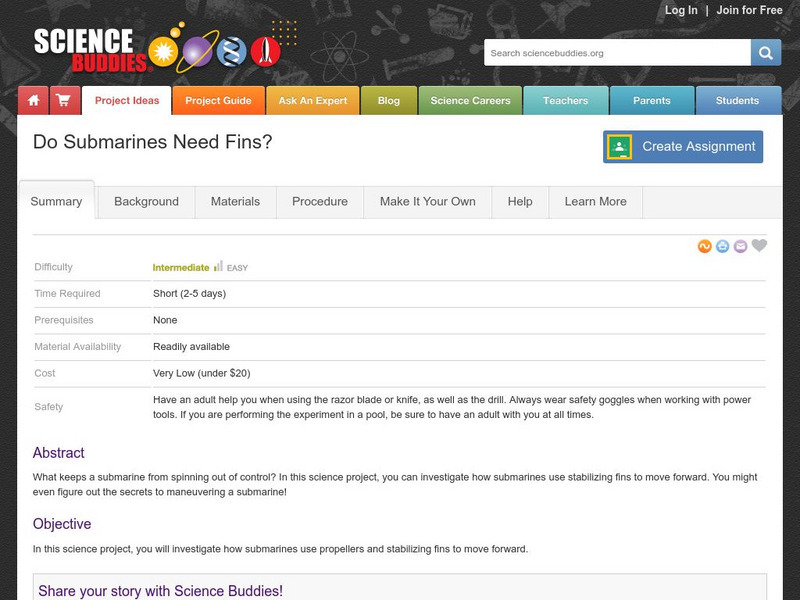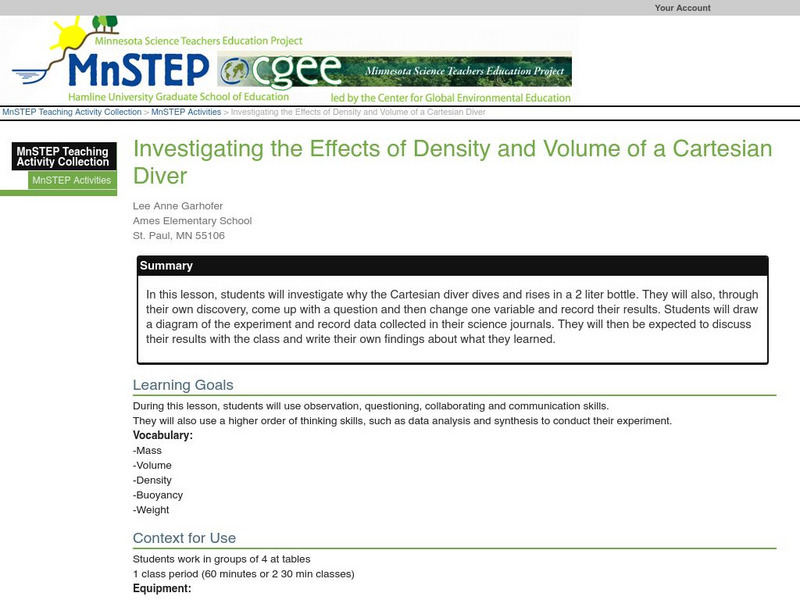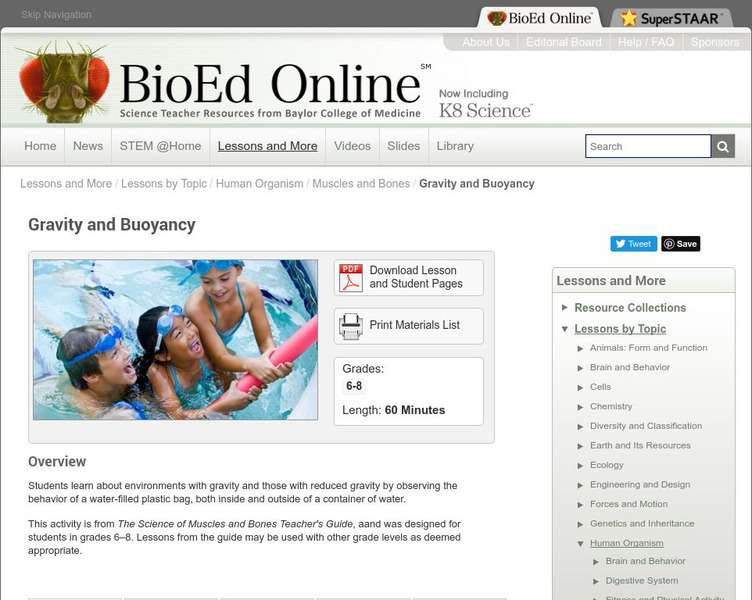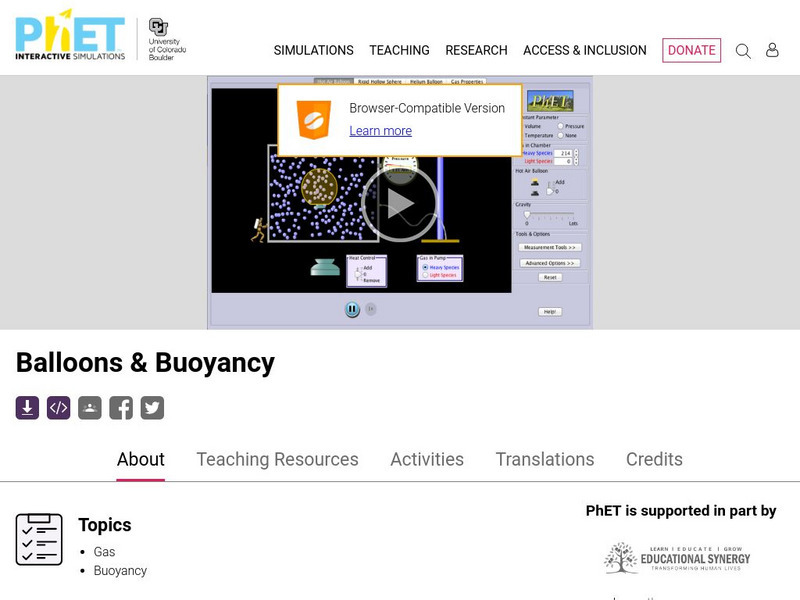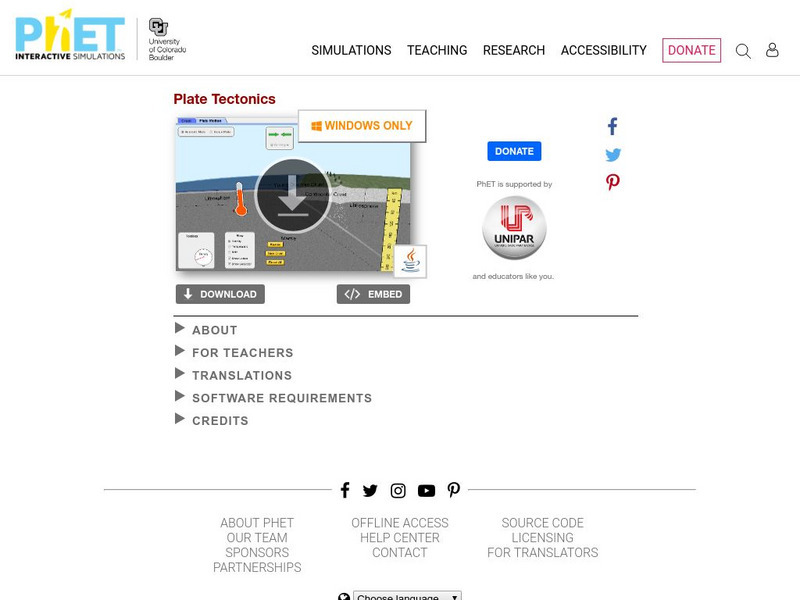Curated OER
Buoyancy
Students look at clippings of boats. They are able to define the following terms displacement, and density. Students construct a clay boat. After they complete their clay boat students answer questions about their clay boats.
Curated OER
The Buoyancy Factor
Students examine why some objects float in water while others sink and the ability of something to float does not depend entirely on its weight. Archimedes' principle is introduced and buoyant force is discussed. Practice calculations...
Curated OER
Secrets Beneath the Waters
Students work in small groups and design a ship out of balsa wood. They hypothesize what happens when the ship is placed in water then make predictions as to which ship stays afloat the longest with the greatest amount of weight added.
Curated OER
How Wet Can You Get?
Students visit a swimming pool and brainstorm different water sports and what benefits swimming has over other types of exercise. They then discuss buoyancy and water pressure and when how objects sink or float before playing a game of...
Curated OER
Marine Debris
Young scholars will perform experiments to examine if debris will float, or blow in the wind. They discuss the effects of these characteristics on marine debris.
Curated OER
Galapagos Rift Expedition Come On Down!
Students research the development and implementation of a research vessel/vehicle used for deep ocean exploration. In this oceanography lesson, students calculate the density of objects by determining the mass and volume.
Curated OER
Boy, Is That Buoyant!
Fourth graders see that salt increases the density of water and creates a condition wherein objects are more buoyant than would be expected under normal conditions. They describe the relationship between heat energy, evaporation and...
Curated OER
Thinking It Through: Discrepant Events
Students practice their skills of forming hypotheses by conducting various experiments.
NOAA
Noaa: Boat Building Challenge [Pdf]
Read to find out about the first boat builders. Construct your own boat out of common materials to explore buoyancy.
CK-12 Foundation
Ck 12 Exploration Series: Simulations: Physics: Scuba Training
[Free Registration/Login Required] A simulation to help you understand how a diver floats! Learn the principles of buoyancy and its relationship to the pressure gradient in a liquid in a gravitational field.
PBS
Pbs Learning Media: Buoyancy Brainteasers: Buoyancy Question
This interactive brainteaser from the NOVA: "Voyage of Doom" Web site challenges you to figure out what causes an object to sink.
PBS
Pbs Kids: Design Squad Challenge: Watercraft (Pdf) [Pdf]
Hands-on challenge to build an unsinkable boat out of straws and plastic wrap that can hold twenty five pennies. Provides full list of materials with ideas on how to build, test, evaluate, and redesign it if necessary. Also, includes...
Science Buddies
Science Buddies: Buoyancy of Floating Cylinders
This project presents an interesting puzzle. A disk of wood will float face-up, that is, with its circular cross-section parallel to the surface of the water. A long log of wood, however, floats with the circular cross-section...
Science Buddies
Science Buddies: Bottled Up Buoyancy
Sure you understand what makes submarines cool, they allow us go underwater and explore the sea! But understanding how they function is a completely different matter. This lab will help you investigate how submarines dive and surface by...
Science Buddies
Science Buddies: Do Submarines Need Fins?
In this science project, you can investigate how submarines use stabilizing fins to move forward. Exploring friction and buoyant force you will get closer to understanding how these large ships function. Research resources are included...
Science Education Resource Center at Carleton College
Serc: Investigating the Effects of Density and Volume of a Cartesian Diver
In this lesson, students will investigate why the Cartesian diver dives and rises in a 2 liter bottle. They will also, through their own discovery, come up with a question and then change one variable and record their results. Students...
BioEd Online
Bio Ed Online: Gravity and Buoyancy
In the following lesson for grades 6-8, students learn about environments with gravity and those with reduced gravity by observing the behavior of a water-filled plastic bag, both inside and outside of a container of water.
PBS
Pbs Kids: Design Squad Challenge: Balloon Drive
Hands-on challenge "to make a helium balloon hover in one spot, then move it through an obstacle course using air currents". Provides full list of materials with ideas on how to design, build, and test the balloon's movement. Activity...
University of Colorado
University of Colorado: Ph Et Interactive Simulations: Balloons & Buoyancy
Experiment with a helium balloon, a hot air balloon, or a rigid sphere filled with different gases. Discover what makes some balloons float and others sink.
University of Colorado
University of Colorado: Ph Et Interactive Simulations: Buoyancy
An interactive simulation that teaches about buoyancy and density by applying various forces and modifying the properties of objects and fluids. This simulation can either be downloaded or played online and includes handouts, lesson...
Other
Rms Titanic: Titanic Science: The Story of the Titanic [Pdf]
An activity guide for exploring the science of the Titanic. Learn about principles of shipbuilding, how the Titanic sank, wireless radio, the accuracy of survivors' stories with respect to what really happened, and artifact conservation.
Other
National Engineers Week Foundation: Flinker
Students investigate with common objects to see if they can make something that neither floats nor sinks, but rather "flinks" in the middle.
Simon Fraser University
Chem1 Virtual Textbook: Understanding Density and Buoyancy
As part of a larger resource called "Getting started in Chemistry," this page examines various topics related to density and buoyancy. Included in the study are definition of density and buoyancy, measurements, applications, and examples.
University of Colorado
University of Colorado: Ph Et Interactive Simulations: Plate Tectonics
Windows only - Interact with the tectonic plates of the Earth and see how changing variables affects the plates.







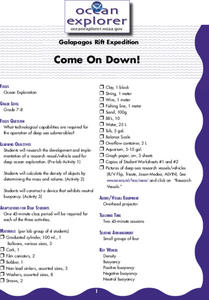
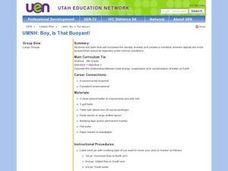

![Noaa: Boat Building Challenge [Pdf] Article Noaa: Boat Building Challenge [Pdf] Article](https://d15y2dacu3jp90.cloudfront.net/images/attachment_defaults/resource/large/FPO-knovation.png)
![Pbs Kids: Design Squad Challenge: Watercraft (Pdf) [Pdf] Handout Pbs Kids: Design Squad Challenge: Watercraft (Pdf) [Pdf] Handout](https://content.lessonplanet.com/knovation/original/39865-57ea89204034120cacf80bcffffff89c.jpg?1661243863)


